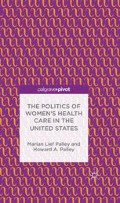Abstract
Women’s health care issues are increasingly a part of the political agenda in the United States. The organized women’s movement has been successful in improving opportunities for women in a number of areas such as education, business, sports and other professions. It has often been successful in changing the definition of women’s health and placing many elements of women’s health care needs on the policy agenda of the United States. Among the areas now recognized as part of the women’s health agenda are inclusiveness of women as part of National Institutes of Health research projects, attention to the risks of hypertension and cardiovascular disease, violence against women, women and the diseases of aging and women as personal and professional caregivers. Also, an area of progressive attention as well as political reaction concerning women’s health is the subject of women’s reproductive rights—including the availability of abortion and, in some instances, contraception.
Access this chapter
Tax calculation will be finalised at checkout
Purchases are for personal use only
Preview
Unable to display preview. Download preview PDF.
References
Boston Women’s Health Collective. 2005. Our Bodies, Ourselves. New York: Simon and Shuster.
Centers for Disease Control (CDC). 2010. “Lack of Health Insurance and Type of Coverage.” http://www.cdc.gov/nchs/data/nhis/earlyrelease/201006_01.pdf. Accessed November 11, 2012.
Clinton, Bill. 1998. “Remarks by the President on the Patients’ Bill of Rights.” May 28. http://clinton2.nara.gov/WH/New/html/19980528-29826.html. Accessed December 23, 2013.
Cobb, Roger and Charles Elder. 1983. Participation in American Politics. New York: Longman.
Gelb, Joyce and Marian Lief Palley. 1996. Women and Public Policies: Reassessing Gender Politics. Charlottesville, VA: University Press of Virginia.
Hendren, John. 1998. “Drug Companies Turning Focus to Women.” Lexington Herald-Leader, January 9. www.kentucktconnect.com/heraldleader/news. Accessed January 15, 2008.
Kingdon, John. 2003. Agendas, Alternatives and Public Policies, Second Edition. New York: Longman.
Mann, Charles. 1995. “Women’s Health Research Blossoms: Closing Gender Disparities in Medical Research and Treatment.” Science, 269 (5225): 766–70.
Medline Plus. 2013. “Heart Disease in Women.” National Heart, Lung, and Blood Institute. Washington, DC: US National Library of Medicine, National Institutes of Health. http://www.nlm.nih.gov/medlineplus/heartdiseaseinwomen.html. Accessed May 1, 2013.
Murray, Anne Firth. 2008. From Outrage to Courage. Monroe, ME: Common Courage Press.
National Institutes of Health (NIH) and Alcohol, Drug Abuse, and Mental Health Administration (ADAMHA). 1990. “NIH/ADAMHA Policy Concerning Inclusion of Women in Study Populations.” NIH Guide. August 24. 19(31): 18–19 (PT. 34, II; 1014002, 1014006.)
National Women’s Law Center. 2012. Women’s Poverty Rate Stabilizes, Remains Historically High—Analysis of New 2011 Census Poverty Data. http://www.nwlc.org/womens-poverty-rate-stabilizes-remains-historically-high. Accessed April 29, 2013.
NBC Sports. 2011. Senator Mikulski: We Wanted to Show … We Could Listen Together. http://nbcsports.msnbc.com/id/22825103/vp/41265770#41265770. Accessed January 2, 2012.
Norsigian, Jill. 1996. “The Women’s Health Movement in the United States.” In Man Made Medicine, edited by Kary Moss, 79–97. Durham NC: Duke University Press.
Palley Howard A. 1995. “The Evolution of FDA Policy on Silicone Breast Implants: A Case Study of Politics, Bureaucracy, and Business in the Process of Decision-Making.” International Journal of Health Services, 25(4): 573–91.
People’s Medical Society Newsletter. 1994. “Fairer Treatment of the ‘Fairer Sex’.” April 1. http://www.highbeam.com/doc/1G1-15244373.html. Accessed April 29, 2013.
Pollitt, Krista. 2011. “After Budget Showdown, Women Under the Bus.” The Nation, May 3, 12.
Ranji, Usha and Alina Salganicoff. 2011. Women’s Health Care Chartbook. Menlo Park, CA: Kaiser Family Foundation. http://www.kff.org/womenshealth/upload/8164.pdf. Accessed May 1, 2013.
Roosevelt, Edith Kermit. 1993. “Correcting the Gender Health Gap.” Nutrition Health Review, 65:18.
Schneider, Anne L. and Helen Ingram. 1993. “Social Construction and Target Populations: Implications for Politics and Policy.” American Political Science Review, 87(2): 334–47.
Schroedel, Jean-Reith and Daniel R. Jordan. 1998. “Senate Voting and Social Construction of Target Populations: A Study of AIDS Policy Making, 1987–1992.” Journal of Health Politics, Policy and Law, 23(1): 107–32.
Schroeder, Patricia and Olympia Snowe. 1994. “The Politics of Women’s Health.” In The American Woman, edited by Cynthia Costello and Anne J. Snowe, 91–108. New York: W.W Norton.
Skocpol, Theda 1997. Boomerang. New York: W.W. Norton.
Society for the Advancement of Women’s Health Research (SAWHR). 1996. “Women’s Health Fact Sheet.” Washington, DC: SAWHR.
Stone, Deborah. 2002. Policy Paradox. New York: W.W. Norton.
United Nations Population Fund. 2007. The Millennium Development Goals Report. New York: United Nations. http://www.un.org/millenniumgoals/pdf/mdg2007.pdf. Accessed January 5, 2008.
U.S. Census Bureau. 2012. Expectation of Life and Expected Deaths by Race, Sex, and Age: 2008. Washington, DC: U.S. Government Printing Office, Table 107. http://www.census.gov/compendia/statab/2012/tables/12s0107.pdf. Accessed May 2, 2013.
U.S. Government Accounting Office. 1990. National Institutes of Health: Problems in Implementing Policy on Women’s Health in Study Populations. Washington, DC: U.S. Government Accounting Office.
Weiss, Lawrence D. 1997. Private Medicine and Public Health. Boulder, CO: Westview Press.
Copyright information
© 2014 Marian Lief Palley and Howard A. Palley
About this chapter
Cite this chapter
Palley, M.L., Palley, H.A. (2014). Rethinking a Women’s Health Care Agenda in the United States. In: The Politics of Women’s Health Care in the United States. Palgrave Pivot, New York. https://doi.org/10.1057/9781137008633_1
Download citation
DOI: https://doi.org/10.1057/9781137008633_1
Publisher Name: Palgrave Pivot, New York
Print ISBN: 978-1-349-43571-5
Online ISBN: 978-1-137-00863-3
eBook Packages: Palgrave Political Science CollectionPolitical Science and International Studies (R0)

